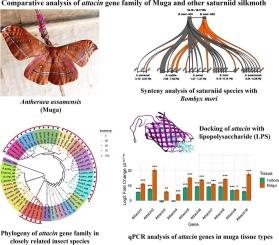Genome-wide analysis reveals expansion and structural rearrangements of the attacin gene family in saturniid silkmoths
IF 2.2
2区 生物学
Q4 BIOCHEMISTRY & MOLECULAR BIOLOGY
Comparative Biochemistry and Physiology D-Genomics & Proteomics
Pub Date : 2025-08-10
DOI:10.1016/j.cbd.2025.101597
引用次数: 0
Abstract
Antimicrobial peptides (AMPs) are essential components of insect immunity, yet the attacin gene family remains poorly studied in Saturniidae. Despite comprehensive functional studies on AMPs across various lepidopteran taxa, the attacin gene family remains insufficiently characterized in Antheraea assamensis (A. assamensis) and related saturniid silkmoths. Here, we present a comprehensive genome-wide analysis across five saturniid silkmoths, identifying 10 attacin genes in A. assamensis, 9 in Antheraea pernyi (A. pernyi), 5 in Antheraea mylitta (A. mylitta), 4 in Antheraea yamamai (A. yamamai), and 10 in Samia ricini (S. ricini). Domain analysis revealed that while most Attacins possess both N- and C-terminal glycine-rich domains, several encode truncated isoforms and some with extended polypeptide lengths. Phylogenetic analysis demonstrated lineage-specific expansions, and aBSREL analysis identified positive selection acting on certain clades, particularly those encoding C-terminal-only isoforms. Conserved microsynteny with Bombyx mori (B. mori) supports a shared evolutionary origin despite scaffold variation. In silico structural modelling and molecular docking predicted high-affinity interactions between Attacin peptides and bacterial lipopolysaccharides (LPS), implicating their role in membrane disruption. Finally, qRT-PCR analysis revealed that several attacin paralogs, particularly attacin5 to attacin8, were significantly upregulated in both the fat body and midgut of A. assamensis following E. coli infection. Notably, attacin2 and attacin10 exhibited higher expression levels in the midgut, highlighting their potential roles in both systemic and gut-localized immune responses.

全基因组分析揭示了饱和家蚕攻击基因家族的扩展和结构重排
抗菌肽(AMPs)是昆虫免疫的重要组成部分,但对其攻击基因家族的研究仍然很少。尽管对各种鳞翅目类群的AMPs进行了全面的功能研究,但在阿萨姆柞蚕(a.a assamensis)及其相关的家蚕中,攻击素基因家族的特征仍然不够充分。在此,我们对5种柞蚕进行了全面的全基因组分析,鉴定出了阿萨姆蚕中10个亲和力基因,柞蚕中9个,mylitta中5个,yamamai中4个,Samia ricini中10个。结构域分析表明,虽然大多数atacins同时具有N端和c端富含甘氨酸的结构域,但有一些编码截断的同工异构体,一些具有延长的多肽长度。系统发育分析显示了谱系特异性扩展,aBSREL分析发现正向选择作用于某些进化支,特别是编码仅c端同种异构体的进化支。与家蚕(家蚕)保守的微同系性支持一个共同的进化起源,尽管支架变异。在硅结构建模和分子对接预测了攻击肽和细菌脂多糖(LPS)之间的高亲和力相互作用,暗示了它们在膜破坏中的作用。最后,qRT-PCR分析显示,大肠杆菌感染后,阿萨默菌的脂肪体和中肠中有几个攻击相似物,特别是攻击相似物5和攻击相似物8的表达显著上调。值得注意的是,attacin2和attacin10在中肠中表达水平较高,这突出了它们在全身和肠道局部免疫反应中的潜在作用。
本文章由计算机程序翻译,如有差异,请以英文原文为准。
求助全文
约1分钟内获得全文
求助全文
来源期刊
CiteScore
5.10
自引率
3.30%
发文量
69
审稿时长
33 days
期刊介绍:
Comparative Biochemistry & Physiology (CBP) publishes papers in comparative, environmental and evolutionary physiology.
Part D: Genomics and Proteomics (CBPD), focuses on “omics” approaches to physiology, including comparative and functional genomics, metagenomics, transcriptomics, proteomics, metabolomics, and lipidomics. Most studies employ “omics” and/or system biology to test specific hypotheses about molecular and biochemical mechanisms underlying physiological responses to the environment. We encourage papers that address fundamental questions in comparative physiology and biochemistry rather than studies with a focus that is purely technical, methodological or descriptive in nature.

 求助内容:
求助内容: 应助结果提醒方式:
应助结果提醒方式:


